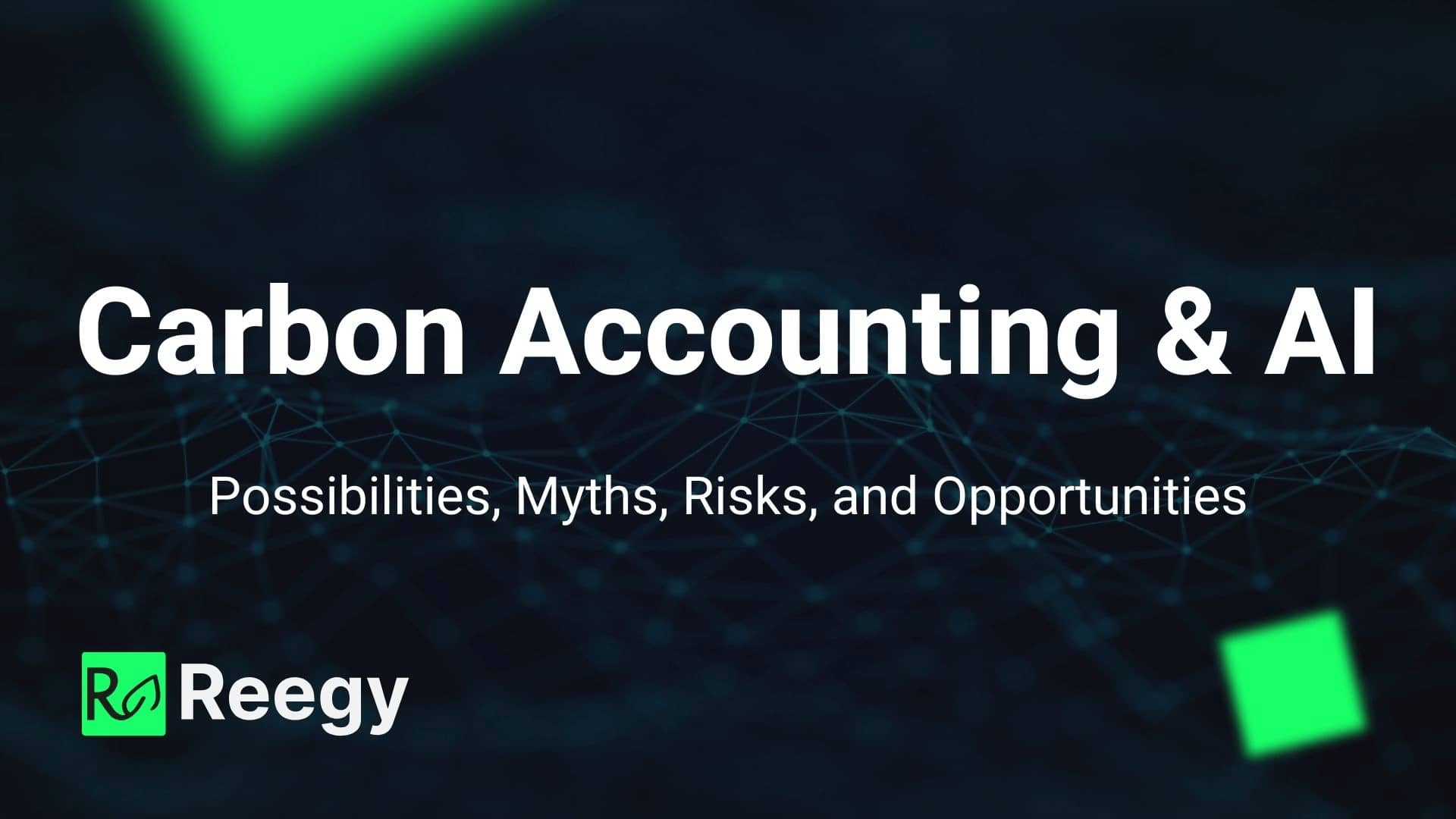
In times of ever more sophisticated artificial intelligence, combining carbon accounting & AI to improve climate action and enhance environmental, social, and governance (ESG) reporting is a powerful tool for every business.
However, what can artificial intelligence do or not do to tackle climate change and carbon accounting needs? And is it truly the game changer we make it out to be?
For businesses wanting to lower their emissions and disclose them properly, understanding how AI can aid in carbon accounting is crucial.
In this article, we will give you a realistic view of the opportunities and risks of AI for your climate action, debunk some myths, and show you, how you can use AI in your own business in 2024!
Tackling Climate Change with AI
Not just since the rise of ChatGPT and self-driving cars, AI has been hailed as the next world-changing technology. And with climate change being one of the greatest threats humanity faces, this seems like the perfect match.
There are many approaches to how companies and startups apply AI to tackle climate change in many different fields. From climate intelligence and risk assessments to insurance, carbon offsets, and of course carbon accounting.

As a rule of thumb, the more data is available, and the more systematic, the bigger the impact of applying AI.
The more data is available, and the more systematic, the bigger the impact of applying AI.
Understanding Artificial Intelligence
Generally speaking, artificial intelligence is used in machines and software to make them act smarter and more autonomous. They may emulate human-like behavior or functioning or extend our capabilities and performance.
Artificial intelligence is a vast approach that includes a number of different categories, research fields, and applications. There are many resources out there if you want to learn more about it, and here we will give you just a brief introduction.
However, even as business professionals in other fields, it is still important to have a basic understanding of what AI actually is in order to make informed business decisions.
After all, AI is only as good as the data you feed it and the algorithms it uses!
AI is only as good as the data you feed it and the algorithms it uses!
Types of AI
There are four types of AI based on their functionality that you may come across.
Reactive Machines: These AIs react to specific situations based on pre-defined algorithms. They don’t retain previous experiences. An example is IBM’s Deep Blue, which defeated the chess champion Garry Kasparov.
Limited Memory: Utilizes past experiences (data) to inform decisions. Most current AI, like self-driving cars that adapt based on past data, falls here.
Theory of Mind: A futuristic concept wherein machines would have the ability to understand human emotions, beliefs, intentions, and other mental processes.
Self-aware AI: An advanced form where machines would have their consciousness, emotions, and self-awareness. It’s purely hypothetical at this point.
Classifications
AI is often classified intro three distinct categories:
Artificial Narrow Intelligence (ANI): Also called “weak AI”, it specializes in performing a single task. Most current AI applications, from chatbots to recommendation systems, fall into this category.
Example: Search Engines, ChatGPT, Self-driving cars
Artificial General Intelligence (AGI): Machines that can perform any intellectual task that a human being can do. They would have the ability to understand, learn, and apply knowledge in different domains. This form of AI, also called “strong” is still theoretical.
Example: Robots from Star Wars or Star Trek
Artificial Superintelligence (ASI): This goes beyond human capabilities, combining the best of human intelligence traits like general wisdom, creativity, social skills, and more. It’s a speculative concept and a topic of debate among futurists and AI ethicists.
Example: Autonomous robots that can act on their own and potentially think on their own.
Common Technologies
Here are the most common technologies and techniques used in AI that you should know about.
It can also help you determine the quality of the products you consider based on their approach.
Neural Networks: Algorithms designed to recognize patterns. They interpret sensory data through a kind of machine perception, labeling, or clustering of raw input.
Deep Learning: A subset of neural networks with many layers, often used for image and speech recognition.
Natural Language Processing (NLP): Allows machines to understand and respond to human language.
Robotics: A field of engineering focused on the design and production of robots, which are often infused with other AI technologies to perform tasks.
Expert Systems: Computer systems that emulate the decision-making ability of a human expert in certain areas.
Machine Vision: Gives machines the ability to see and interpret visual information from the world.
Machine learning: Machine Learning is a subset of AI that focuses on the development of algorithms that allow computers to learn from and make decisions or predictions based on data. The “learning” aspect refers to the ability of the algorithm to improve its performance on a task over time without being explicitly programmed for that task.
Current Use Cases of Artificial Intelligence in Carbon Accounting
AI and machine learning are already used in carbon accounting and to tackle climate change in several fields. This includes anomaly detection & inconsistency fixing, creating ESG reports, recommending emission factors, and predicting corporate emissions.
The use of AI in carbon accounting is no longer a mere concept; it’s already state-of-the-art (but needs big improvements still).
Leading companies are leveraging machine learning to analyze satellite images, and detect deforestation or other environmental changes. Natural language processing (NLP) aids in scanning vast amounts of literature and reports, extracting valuable insights for ESG reporting.
Also, neural networks, a subset of AI, have become instrumental in predicting emissions based on complex datasets.
Here are some examples of AI in carbon accounting:
Efficiency and Precision
Manual carbon accounting can be a lengthy and error-prone process. Remember all those emails and Excel sheets?
AI can automate and refine the collection and analysis of data, ensuring timely and accurate results. The more data you feed the system, the more accurate it becomes.
Anomaly detection and Inconsistency fixing
Using kNN-clustering and machine learning, programs can detect anomalies in the data that’s fed to the system and fix inconsistencies it finds.
While not perfect, yet, this approach is already available in some carbon accounting platforms, like Reegy’s Eco Hub!
Reporting and ESG disclosures
Natural language processing (NLP) can be used to analyze existing data and provide insights for ESG reports. Our ESG Reporting Module also lets you automatically create ESG reports based on your data and without any effort!
Emission Factor Recommendations
If you have ever created a carbon report, you know that there are hundreds of emission factor databases and thousands of emission factors. Using GPT and machine learning, advanced carbon accounting software can make this process go much smoother and save you hundreds of hours in the process!
Supply Chain Analysis
AI can track emissions across complex supply chains, identifying areas of high carbon output and offering solutions for mitigation. This is super important for lowering your company’s scope 3 emissions and becoming more climate-friendly!

Opportunities for AI in Carbon Accounting
AI offers many opportunities to be used in carbon accounting and truly become the game changer we hope it to be:
Predictive Analytics: AI can forecast future emissions trends based on current data, helping businesses strategize and make informed decisions.
Personalized Recommendations: AI algorithms can provide tailored suggestions for reducing carbon footprints, by analyzing a company’s unique operations and needs.
Real-time Monitoring: With sensors and IoT devices, AI can facilitate real-time tracking of emissions, alerting companies to unforeseen spikes or inefficiencies.
However, not all of these are created equal.
AI is great and reasonably reliable for analyzing existing data and giving you insights on it. However, the more into the future we want to look, the less reliable it becomes.
Predictive analytics are still somewhat limited and should be treated with caution.
Personalized recommendations that go beyond meta suggestions (“reduce air travel”) and offer unique action plans (“replacing component A with B will save 12.981% emissions per year at a cost increase of 0.2365%”) are still a work in progress.
Our customized action plans are still an experimental feature, however, we hope to release them by Q4/2024!
Risks and Limitations of AI
Although artificial intelligence has the potential to become a true game changer in battling climate change, there are also risks and limitations you should be aware of:
Data Privacy: Handling vast amounts of data raises concerns about security and confidentiality.
If you buy an AI solution take appropriate measures to ensure data integrity and check the location of the servers. Especially in Europe, you will find stricter data privacy laws which means your data will be safer!
Reliability of the Results: While AI can streamline processes, you should never trust it blindly! Remember what we said above: AI is only as good as the data you feed it and the algorithms it uses.
Similar to ChatGPT where you should always fact-check results and autonomous driving that still requires a driver to be present, always double-check carbon accounting results!
Technical & Financial Challenges: Implementing AI solutions might require an initial investment in infrastructure and skills, which can be a barrier for some organizations.
If you invest in a new solution, do your due diligence and make sure you understand the product thoroughly!
AI cannot do it alone: AI is only one tool in the toolbox to reduce emissions, tackle climate change, and automate your carbon accounting and ESG reporting.
In the end, you and your company need to take the steps required like making changes to your supply chain, purchasing more energy-efficient machinery, or implementing an effective climate strategy.
How can AI become a game changer for carbon accounting and ESG reporting?
The simple answer to this question is: Use it!
According to IBM, AI only has an adoption rate of 25% in the United States. While Capgemini estimates this number to be at around 52% for the EU, we still need a much higher adoption rate if we want to achieve significant improvements and breakthroughs.
If you have any questions on how we use AI at Reegy to make carbon accounting easier for you, send us a message! 💚
Conclusion
Carbon accounting and AI are a perfect match if you know how to use it, and what results you can expect.
Talk to us so we can show you how Reegy uses AI to streamline carbon accounting, and ESG reporting and helps you every step of the way to automate your sustainability management!
Reegy is a complete software solution for ESG & Carbon Footprint Management. Our Reegy Eco Hub enables enterprises, financial institutions and governmental organizations to manage their climate action in one central location along the entire value chain. Track, measure, reduce, and offset your carbon emissions, disclose them to regulators, stakeholders, and customers and lead your company to Net Zero on autopilot!